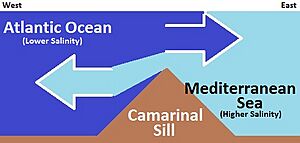Camarinal Sill facts for kids
The Camarinal Sill is like a shallow underwater ridge or doorstep that separates the Mediterranean Sea from the Atlantic Ocean. It's the shallowest part of the seafloor between Spain (the Iberian Peninsula) and Africa. This important underwater feature is located about 25 kilometers (15 miles) west of the narrowest part of the Strait of Gibraltar. It sits at a depth of about 280 meters (918 feet) below the surface, at 35°56′N 5°45′W / 35.933°N 5.750°W.
Contents
How the Camarinal Sill Formed
The Camarinal Sill was formed a very long time ago, during a major event called the Messinian salinity crisis.
The Messinian Salinity Crisis
About 6 million years ago, the Mediterranean Sea became almost completely cut off from the Atlantic Ocean. This caused the Mediterranean to dry up a lot, leaving behind huge salt deposits. Imagine a giant bathtub slowly losing its water!
The Zanclean Flood
Then, about 5.3 million years ago, something dramatic happened. The Atlantic Ocean suddenly broke through the land barrier, creating the Strait of Gibraltar. This event is known as the Zanclean flood. A massive amount of water rushed into the Mediterranean Sea, refilling it very quickly. This powerful flood carved out a deep gorge, about 900 meters (3,000 feet) deep, that lies beneath the water today. The Camarinal Sill is believed to have formed during this incredible refilling process.
Another Idea for Formation
Some scientists have a different idea. They think that both the deep gorge and the Camarinal Sill were formed by rivers carving out the land when the Mediterranean Sea was drying up during the Messinian salinity crisis. This means the features might have been there before the big flood.
Water Flow and Submarines
The Camarinal Sill plays a big role in how water moves between the Atlantic Ocean and the Mediterranean Sea.
Ocean Currents
For water to flow between these two large bodies of water, it must pass over this shallow sill. There are two main currents:
- A warmer, less salty current flows from the Atlantic Ocean into the Mediterranean Sea at the surface.
- A cooler, saltier current flows from the Mediterranean Sea out into the Atlantic Ocean along the bottom.
Submarines in World War II
During World War II, submarines used these natural currents to their advantage. They could travel in and out of the Mediterranean Sea without using their engines. By riding the upper inflow current or the lower outflow current, they could move quietly and avoid being detected from the surface. This was a clever way to stay hidden!
See also
 In Spanish: Umbral de Camarinal para niños
In Spanish: Umbral de Camarinal para niños



